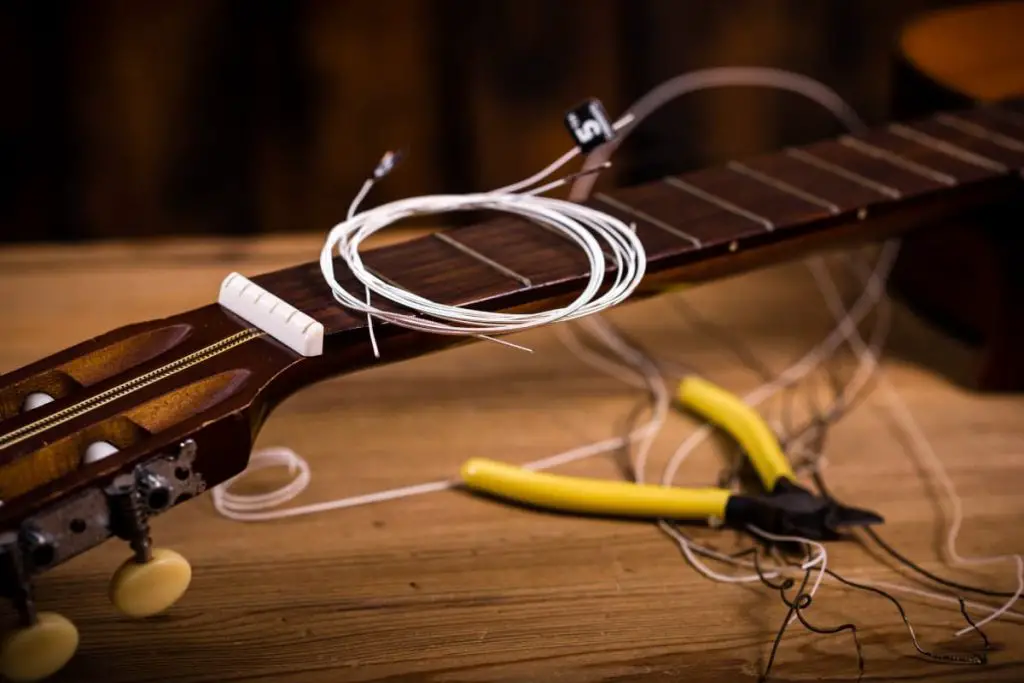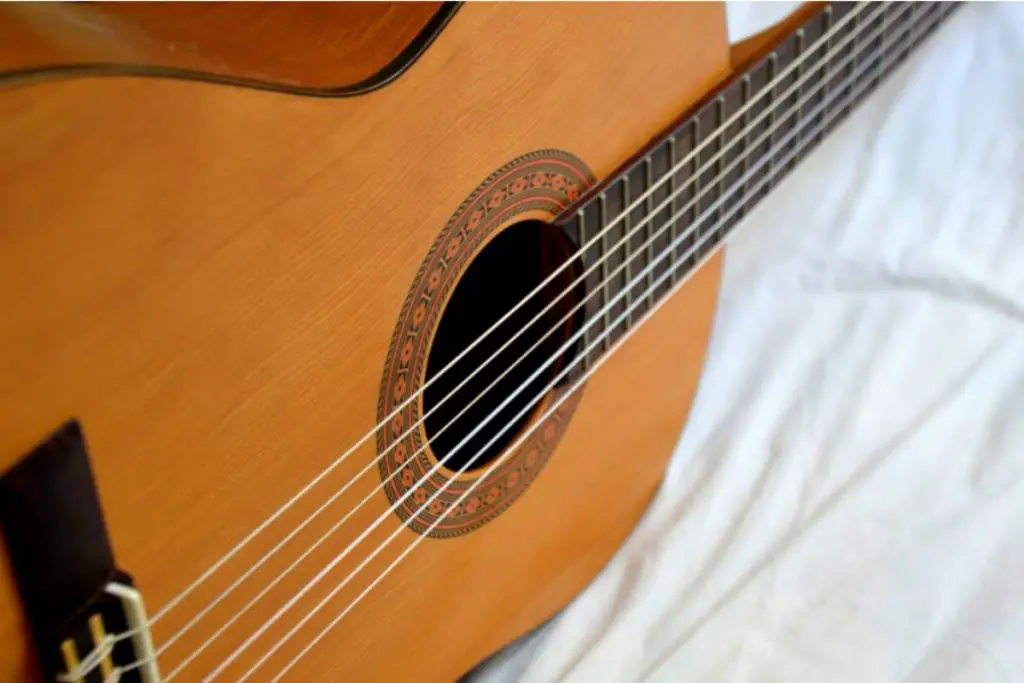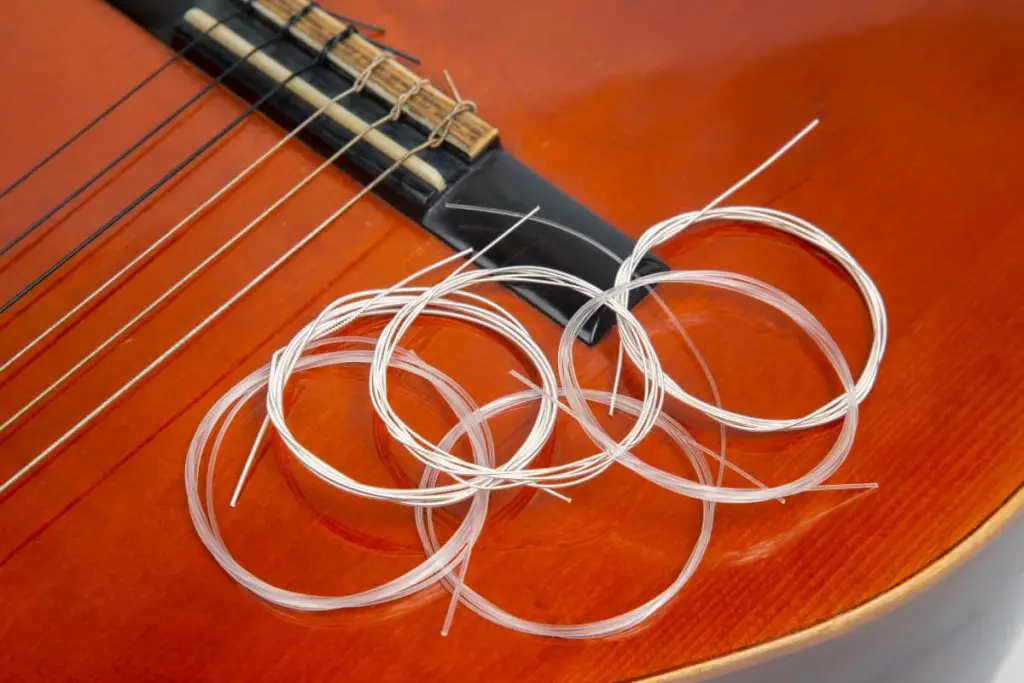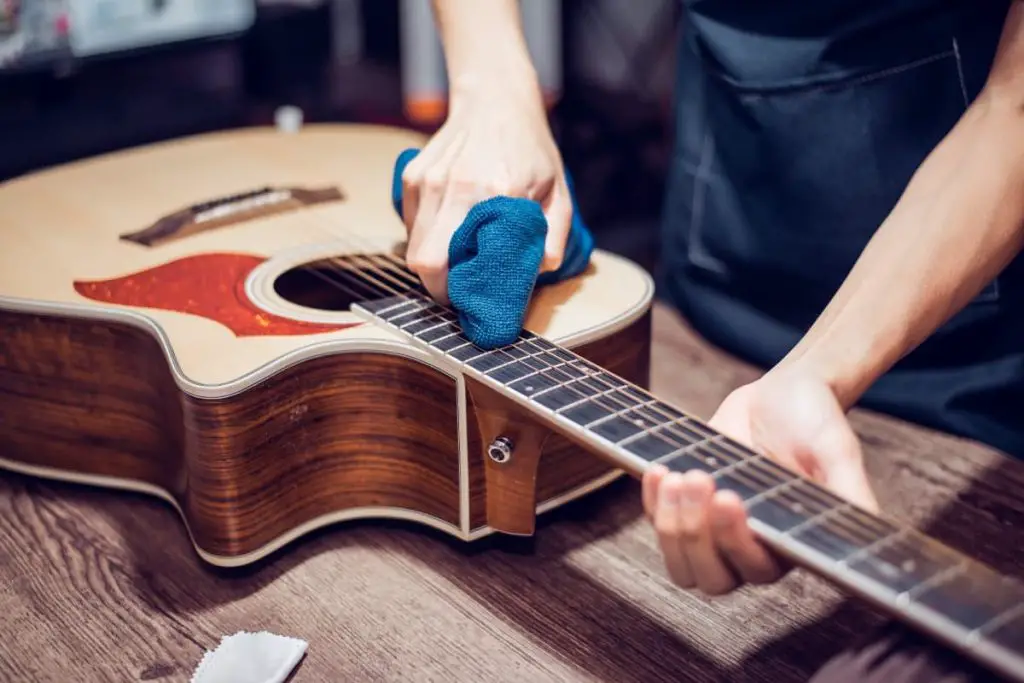As any guitarist worth their salt will tell you, guitar strings should be in the best condition to deliver clean, clear tones as you play them. So how do you know when it’s time to change those strings?
Here are six signs that your guitar strings need replacing:
- The strings sound dull.
- The strings look stained.
- The strings are no longer in tune.
- The strings leave stains on your fingers.
- The strings feel stiff.
- The strings have been used for at least 3 months.
In the rest of this article, I will explain these signs in more detail. I’ll also look at how you can change your strings depending on the type of guitar you have. Finally, I’ll discuss how to maintain your guitar strings so they can serve you for as long as possible.
👇😀👇NOTE👇😀👇
If you want to find out what my recommended guitar gear is, then here is what I recommend on Amazon:
- Fender Cutaway Acoustic-Electric Guitar Bundle (MY FAVORITE GUITAR)
- Snark SN-8 Super Tight All Instrument Tuner (Easiest Tuner I’ve Used😏)
- 6 String Acoustic Guitar Capo (Best CAPO for quick changes)
- Dunlop Max Grip 1.0mm Nylon Picks (Thick Guitar Pick So You Don’t Lose Grip!)
- Universal Guitar Stand (Cheap & Minimalist Guitar Stand I Recommend)
- Levy’s 2″ Wide Quick Adjust Guitar Strap (Best Guitar Strap For Any Level)

1. The Strings Sound Dull
New guitar strings usually have a sharp twangy sound (except if they’re nylon strings, which have a softer sound). Over time, they lose this sharpness and clarity due to constant exposure to the elements. If you continue to use dull strings without replacing them, they’ll eventually start to sound lifeless.
2. The Strings Look Stained
Your guitar strings should be bright and shiny. If you see stains on them, it’s likely a sign that corrosion is starting to take hold of the strings. As soon as this happens, the strings should be changed to ensure that your guitar continues to perform at its best.
3. The Strings Are No Longer in Tune
Whether your strings are steel/nickel or nylon, being out of tune is usually a sign that you need to replace your guitar strings. But before you do so, let me talk about when to replace out-of-tune guitar strings according to their type.
Out-of-Tune Steel/Nickel Strings
When steel/nickel strings are new, they need to be “broken in.” That means you need to adjust the tension often to keep them in tune. In other words, out-of-tune steel/nickel strings that are new aren’t necessarily problematic. However, if your steel/nickel guitar strings start to go out of tune after you’ve used them for weeks or months, you need to restring your guitar.
Out-of-Tune Nylon Strings
Being out-of-tune is more of a problem for nylon strings since they tend to experience minor expansions after prolonged use and exposure to the elements. Since your strings need to be at a precise tension level to stay in tune, any expansion will cause the strings to go out of tune. As with steel/nickel strings, you need to replace nylon strings if they’re out-of-tune and have been used for a relatively long time.

4. The Strings Leave Stains on Your Fingers
If you run your fingers over your strings and you see dirt sticking to your fingers, you need to restring your guitar. When strings are exposed to the elements (e.g. the moisture and oil from your fingers), they can begin to corrode and leave tiny particles on your fingers when you play.
You can clean the stains off your guitar strings now and then. However, if you hear a decrease in the clarity of your guitar’s sound, and you feel that the material of the strings has lost its integrity, that’s usually your cue to restring your guitar.
5. The Strings Feel Stiff
Guitar strings should be flexible and responsive to the touch. Their ability to vibrate (or the lack thereof) affects their sound quality. If they feel stiff to the touch, they won’t vibrate as smoothly as they should, resulting in a flat guitar tone. You’re also forced to strike them harder to create the sound you want, which increases your likelihood of injuring yourself. Therefore, you should immediately replace strings that feel stiff.
6. The Strings Have Been Used for at Least 3 Months
No matter how well you think your guitar strings are performing, you should replace them after they’ve been used for at least 100 hours. If you’re not an active player but have had the strings strung for up to 3 months, you should also replace them to get the best tone and performance.
Why Should You Use New Guitar Strings?
You should use new guitar strings to ensure the best tone and performance every time you play your guitar. Also, corroded strings can harm your fingers, especially when you have to slide over them while playing and end up cutting your skin.

Ideally, you should change your guitar strings every time you need to do things like live concerts or studio recordings. Aside from the fact that old strings reduce the clarity and tonal quality of your guitar, there’s also the risk of them being too weak to handle the rigors of a major performance. The last thing you want is your strings popping on stage.
When you change your guitar strings before a performance, you should ensure you play them for at least a few hours first so they can be properly “broken in.” Besides, you’re probably going to do rehearsals anyway, so doing this helps you kill two birds with one stone.
How To Change Your Guitar Strings
It should go without saying that every guitar player should know how to change their guitar strings. As I’ve said earlier, you may need to do this at least once every three months.
The best way to restring a guitar depends on what type of guitar it is. Therefore, I’ll give you step-by-step guides on how to restring each guitar type in the following sections. For the sake of brevity, I’ll focus on the acoustic guitar, classical guitar, and electric guitar.
How To Change Acoustic Guitar Strings
To change acoustic guitar strings, you need a string winder and a string (wire) cutter.
If you want a tool that can wind and cut guitar strings at the same time, I recommend the D’Addario Pro-Winder – Guitar String Winder (available on Amazon.com). Aside from its versatility, this tool is especially useful for owners of acoustic guitars.
Of course, you shouldn’t forget your new set of replacement strings.
Follow these steps to change your acoustic guitar strings:
- Slacken the tension of the old strings.
- Remove the old strings. You can loosen the strings completely before pulling them out from the bridge, or you can slacken them a little and then cut close to the bridge to remove them more quickly.
- Carefully clean the fretboard to remove any accumulated dirt.
- Insert the new strings one at a time.
- Remove the bridge pin and insert the knotted end of the string into the bridge hole.
- Reinsert the bridge pin and push it down with the pin’s fluted side facing the string while pulling up the string at the same time.
- With the string’s knotted end firmly in the bridge hole, stretch the string past its corresponding tuning peg by a few inches. For example, the thickest string (E) goes to the top tuning peg closest to the neck. The A string goes to the top middle tuning peg while the D string goes to the top tuning peg farthest from the neck.
- Using the string cutter, cut off the excess string for easy stringing.
- Insert the string into the peg hole. Allow only a small part of the string to come out at the other end of the hole. This gives enough slack on the string for the stringing
- With the string inserted and using the string winder, turn the tuning peg anti-clockwise until the string is taut. Ensure that the string starts circling the tuning peg from the top and spirals down without overlapping. Do not try to tune it yet.
- Repeat the process for all the strings before you begin to tune the guitar (here’s how to keep guitar tuning pegs from slipping).
You may have heard that you shouldn’t remove all your guitar strings at once when restringing. I don’t think this really matters, though. If you replace the strings in pairs instead of first removing everything before restringing, it won’t negatively affect your guitar. If you remove everything, it shouldn’t cause any issues unless you don’t restring everything properly.
You can watch this YouTube video by Fender to see precisely how restringing is done:
How To Change Classical Guitar Strings
The general process for changing classical guitar strings is slightly different from that of steel string acoustic guitars. That’s because there are differences in the bridge and string designs between the two types.

For one, classical guitar bridges have no bridge pins, just a hole through which you need to slide the string. Also, since the classical guitar’s nylon strings don’t have a knotted end, both ends look the same.
To change classical guitar strings, follow these steps:
- Slacken and remove the old strings.
- Clean the fretboard to remove any accumulated dirt.
- Slide any end of the string into the hole in the bridge.
- Pull the string through, knot it over the bridge with a simple knot, and pull it taut.
- While maintaining some tension on the end you just knotted, slide the other end into the hole in the tuning peg at the headstock.
- Pull the string through the hole and make another simple knot around the tuning peg.
- Using the winder, tighten the strings by turning the tuning peg anti-clockwise until they are sufficiently taut.
- Cut off any excess strings from the bridge and the tuning pegs.
You can now begin to tune the strings.
Note that nylon strings stretch and will therefore need constant tuning to keep them in tune.
You can watch this YouTube video from Cordoba for a visual demonstration of the above steps:
How to Change Electric Guitar Strings
Changing the strings on your electric guitar is basically the same as that for your acoustic guitar. However, the different bridge types that electric guitars have and the arrangement of the tuning pegs on the headstock may require you to do restringing a little differently.
Before you get started, you’ll need to know whether your electric guitar is a string-through type or a top loader. If it’s a string-through, the strings will be passed from the back of the guitar to the top. If it’s a top loader, the strings will be passed through a stop tailpiece located on top of the guitar. There will be variations on these stringing options.
To change the strings on your electric guitar, take the following steps:
- Get your new strings, a winder, and a string (wire) cutter.
- Slacken the strings.
- Cut the strings around the pickup area. This will make it easier to pull out from both ends
- Carefully clean the guitar fretboard to remove any dirt buildup.
- Feed your strings through the provided bridge hole and pull until the bolted end of the string latches on. If yours is a string-through type, it will be more convenient to string all six strings through before proceeding to the next step.
- Starting from the low E string (the thickest string), stretch out the string to the third tuning peg and cut it at that point. This gives just the right amount of slack for tuning.
- Insert the string into the first tuning peg (the one closest to the guitar neck).
- Wind the tuning peg anti-clockwise until the string is taut.
- Repeat the process for each string, remembering to give an extension the length of two pegs before cutting the extra string.
- With all six strings strung up, starting from the low E (the thickest string) down to the high E (the tiniest string), you can begin to tune the strings.
You can watch a YouTube video of this from Fender below:
How To Care for Your Guitar Strings
All guitar strings will need to be changed at some point no matter how well you care for them. Still, knowing how to maintain your guitar strings can help them last much longer, minimize corrosion, and lower the risk of hurting or dirtying your fingers.
Wipe the Strings After Playing
Every time you play your guitar, dirt and oil are transferred from your fingers to the strings. Left unchecked, these can cause your strings to corrode more quickly, forcing you to replace them a lot earlier than you want. Therefore, it’s best to clean the strings before and after you play your guitar.

Clean Steel Strings With String Oil
No matter how well you clean your guitar strings, it’s still likely that some moisture will stay on the strings. By cleaning the strings with string oil, you build a protective shield over the strings, reducing the likelihood of corrosion setting in. Also, you keep it sounding sharp and clean for much longer.
Clean the Fretboard Before Restringing
Whenever you change your strings, you should also clean the fretboard thoroughly before putting the strings back on. That way, you can efficiently clear away any buildup of dirt and grime that can easily transfer to your new strings — as opposed to having to awkwardly insert your cleaning cloth and solution between strings just to clean the fretboard.
If you want an all-in-one cleaning solution for your guitar, I recommend the cheekily named Careful With That Axe Guitar Cleaning, Polish and Oil Care Kit (available on Amazon.com). The cleaning solution, in particular, works well with practically every type of guitar finish, so you don’t have to worry about unwanted side effects.
Protect the Strings From Extreme Temperatures
Whether you use steel/nickel or nylon strings, keep them away from extreme weather. Extremely high temperatures will cause the strings to expand more than they should, while freezing weather will cause them to contract. These harsh conditions can easily damage the integrity of the strings, forcing you to replace them too early.
Store the Guitar in Well-Padded Gig Bags or Cases
Storing your guitar in well-padded gig bags or cases protects them from the extreme weather conditions I outlined above. Also, they shield your guitar against humidity and dust particles. The extra padding also prevents your guitar from getting damaged due to excess movement.
When looking for a gig bag, make sure it’s appropriate for the type of guitar you have. For example, the ChromaCast Electric Guitar Nylon Gig Bag (available on Amazon.com) works best for electric guitars. Its black nylon cover keeps your guitar safe from the elements, while the extra pockets are handy for any sheet music you want to practice before live performances.
I also recommend the CAHAYA Electric Guitar Bag Gig Bag (available on Amazon.com). There’s about 6 mm (0.23 in) of padding between your guitar and the elements, so you get adequate protection without adding unnecessary bulk. You can also adjust the straps depending on how you prefer to carry your guitar.
Slacken the Strings Before Traveling or Storing
If you’ll be traveling with your guitar and don’t anticipate using it for a while, you should slacken the strings. Since they won’t be in use, keeping the strings tense is unnecessary. Doing this will relieve tension from the strings and the guitar neck until you’re ready to use the guitar again (Which Guitar String Is the Most Likely To Break?).
👇😀👇NOTE👇😀👇
If you want to find out what my recommended guitar gear is, then here is what I recommend on Amazon:
- Fender Cutaway Acoustic-Electric Guitar Bundle (MY FAVORITE GUITAR)
- Snark SN-8 Super Tight All Instrument Tuner (Easiest Tuner I’ve Used😏)
- 6 String Acoustic Guitar Capo (Best CAPO for quick changes)
- Dunlop Max Grip 1.0mm Nylon Picks (Thick Guitar Pick So You Don’t Lose Grip!)
- Universal Guitar Stand (Cheap & Minimalist Guitar Stand I Recommend)
- Levy’s 2″ Wide Quick Adjust Guitar Strap (Best Guitar Strap For Any Level)
Related Posts:

